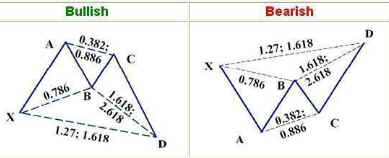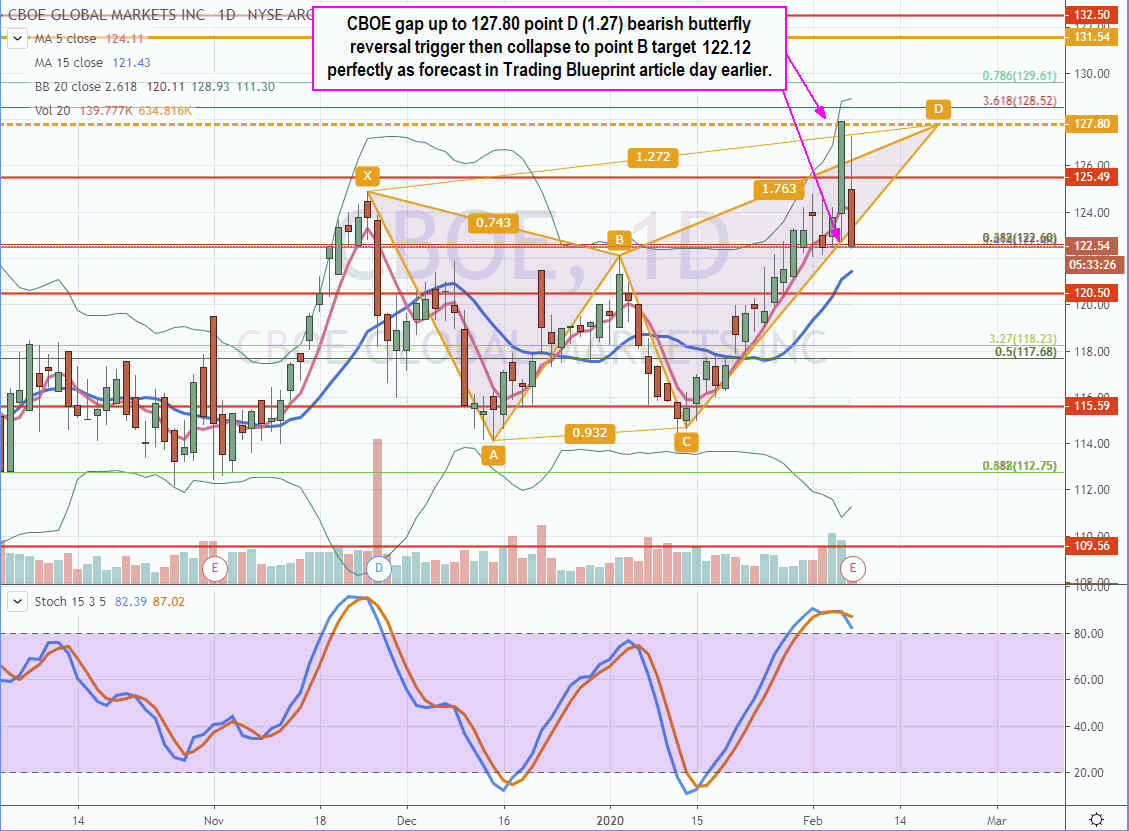Harmonic price patterns are composed of multiple geometric price points connected together to form “legs” that meet specific
Fibonacci (fib) ratio measurement parameters culminating in an anticipated price move when the final price point triggers. They are identified by the shape of the pattern resembling various animals like bats, crabs, sharks, and butterflies. Complex harmonic patterns have a prerequisite set-up of five qualified price points preceding the triggered move. In this article, we will examine the five-point butterfly pattern and how to trade this rare but effective set-up.

The Bearish Butterfly Pattern Set-Up
Aptly named the butterfly since the pattern resembles the wings of a butterfly. We will review the bearish butterfly pattern, which can be traded both long and short. The bullish butterfly is just an inverted version. This harmonic pattern consists of five-points: X (starting), A, B, C and D (trigger). Bearish butterfly patterns start with X at the peak of a price move to the lowest point A of the move down. The bounce from low point A should peak around the 0.786 (78.6%) distance of the X to A leg, which is point B (IE: B = 0.786 of XA). After peaking at point B, price should fall back down to 0.886 (88.6%) distance of the A to B leg (IE: C = 0.886 of AB). We have four of the five points qualified. The final and most important price point is peak of the bounce from point C to point D, which should be a distance of 1.272 (127.2%) distance of the X to A leg (IE: D = 1.272 of XA). When point D triggers, it should cause a reversal price sell-off. The initial target is point B (reversion) with a potential downside to point A (trend reversal). To further galvanize the set-up, the BD leg should fall within the 1.618 to 2.24 of the AB leg and the AC leg should be within 0.382 to 0.886 distance of the XA leg.
Be Flexible
With all that said, there has to be some flexibility with the ratios as some legs may slightly overshoot the exact distance. For butterflies, we prefer the B point to range above 0.618 and below 0.886 and the C point to be higher than A point. A bullish butterfly is just the inverted version of the bearish butterfly. Bearish butterflies form on uptrends and appear like a rising W that provides a reversion at point D that could turn into a downtrend under point C. Bullish butterflies form during downtrends and appear like falling M and provide a reversion bounce at point D than could turn into an uptrend above point C.
The Two Tradeable Legs
The butterfly pattern can be traded both long and short. For a bearish butterfly, the CD leg can be traded long when the point B price breakout forms targeting point X and point D. The point D can be traded short targeting the point B, point C and potentially point A. The inverse holds true on bullish butterfly patterns (IE: Shorting the CD leg and buying the D point).

Bearish Butterfly on CBOE Stock
On Feb. 6, 2020, we identified the potential bearish butterfly pattern for Chicago Board of Exchange Global Markets, Inc. (CBOE) in our Trading Blueprint for CBOE Earnings article ahead of the Q4 2019 earnings release. The completion of the X, A, B, C points enabled us to calculate the point D reversal trigger of $127.80 by using the 1.272 extension of the XA leg, while CBOE was trading at $122.95.
Upon the release of earnings, CBOE immediately spiked to a high price of $127.93 before plunging nearly -$6 to the point B target at $122.12. In this example, the ability to calculate and anticipate the point D trigger price ahead of time proved ample time to be ready to react into the price gap. While textbook examples of harmonic patterns are easy to curve fit to the exact measurements after the fact, real-time trading requires flexibility rather than rigidity. The nuances fall upon the amount of wiggle room applied to the measurements and price point overshoots. These nuances get smoothed out with experience underscoring the belief that technical analysis is more of an art than science.
Coincidence or Confluence?
Pundits will argue that harmonic patterns don’t consistently work and when they do, it’s just coincidence. We find that effective harmonic patterns tend to coincide with a confluence of underlying set-ups all hitting the right trigger to produce an anticipated price move. Just as you wouldn’t use just a single indicator for every trade, a confluence of triggering indicators is the most prudent approach. The CBOE bearish butterfly was just as effective utilizing the rifle charts on the mini inverse pups combined with market structure high (MSH) triggers to signal the short sell. However, the usefulness of the harmonic patterns comes in providing a heads-up ahead of time to identify the point D either as an upside target on the long trade or short-sell trigger on the reversal. Harmonic patterns are rare but effective when combined with other converging trading methods. In future articles, we will examine additional harmonic patterns and how to combine set-ups for high probability outcomes.
Before you make your next trade, you'll want to hear this.
MarketBeat keeps track of Wall Street's top-rated and best performing research analysts and the stocks they recommend to their clients on a daily basis.
Our team has identified the five stocks that top analysts are quietly whispering to their clients to buy now before the broader market catches on... and none of the big name stocks were on the list.
They believe these five stocks are the five best companies for investors to buy now...
See The Five Stocks Here
With the proliferation of data centers and electric vehicles, the electric grid will only get more strained. Download this report to learn how energy stocks can play a role in your portfolio as the global demand for energy continues to grow.
Get This Free Report
Like this article? Share it with a colleague.
Link copied to clipboard.